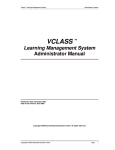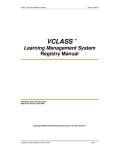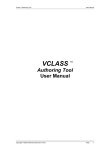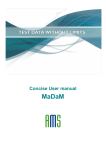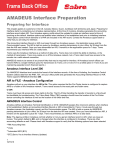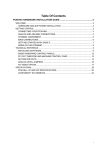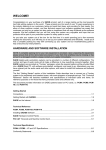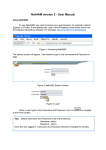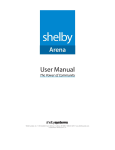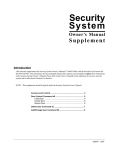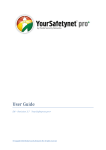Download VCLASS Learning Management System Instructor Manual
Transcript
Vclass Learning Management System Instructor Manual VCLASS Learning Management System Instructor Manual Publication Date: December 2003 Date of last revision: April 2005 Copyright ©2005 by Distributed Education Center. All rights reserved. Copyright © 2005 Distributed Education Center Page 1 Vclass Learning Management System Instructor Manual TABLE OF CONTENTS TABLE OF CONTENTS ........................................................................................................................... 2 TM ABOUT THE VCLASS LEARNING MANAGEMENT SYSTEM INSTRUCTOR MANUAL..................... 3 SECTION 1: VCLASS LMS - THE BIG PICTURE........................................................................................... 5 VClass Learning Management System................................................................................................. 6 Learning about the VClass LMS Environment .......................................................................................... 6 Navigating within the VClass LMS............................................................................................................ 7 What You Will Need In Using the VClass? .............................................................................................. 8 SECTION 2: BASIC CONCEPTS AND SKILLS ............................................................................................... 9 Overview ................................................................................................................................................ 10 Logging into the VClass LMS .............................................................................................................. 10 Avoid Using Back and Forward Buttons ................................................................................................. 10 Logging out from the VClass LMS ....................................................................................................... 11 SECTION 3: VCLASS LMS INSTRUCTOR FUNCTIONS............................................................................. 12 HOME FUNCTION ...................................................................................................................................... 14 COURSES FUNCTION ............................................................................................................................... 15 GENERAL .............................................................................................................................................. 17 SCORE STRUCTURE............................................................................................................................ 18 GRADE STRUCTURE............................................................................................................................ 19 INSTRUCTORS...................................................................................................................................... 20 ONLINE SCHEDULE.............................................................................................................................. 21 COURSE CONTENT.............................................................................................................................. 23 FILE MANAGEMENT ............................................................................................................................. 27 RESOURCE CATEGORIES................................................................................................................... 29 DEFAULT NAV-BAR .............................................................................................................................. 30 CLASSES FUNCTION................................................................................................................................ 31 FACILITATORS...................................................................................................................................... 33 CLASS CALENDAR ............................................................................................................................... 34 ANNOUNCEMENTS .............................................................................................................................. 36 CLASS INFORMATION.......................................................................................................................... 37 PEOPLE ................................................................................................................................................. 38 ACCESS LOG ........................................................................................................................................ 39 WORK SUMMARY BY SESSION .......................................................................................................... 41 GRADING............................................................................................................................................... 43 COURSE BOARD .................................................................................................................................. 44 SEARCH FUNCTION.................................................................................................................................. 46 PEOPLE SEARCH ................................................................................................................................. 47 PERSONAL FUNCTION............................................................................................................................. 49 PERSONAL PROFILE............................................................................................................................ 50 LANGUAGE SETTING ........................................................................................................................... 52 COMMUNICATIONS FUNCTION ............................................................................................................... 53 WEB BOARD.......................................................................................................................................... 54 ONLINE CHAT ....................................................................................................................................... 56 CALENDAR ............................................................................................................................................ 58 Copyright © 2005 Distributed Education Center Page 2 Vclass Learning Management System Instructor Manual ABOUT THE VCLASSTM LEARNING MANAGEMENT SYSTEM INSTRUCTOR MANUAL Overview This manual was originally commissioned by the Distributed Education Center, a subunit of Internet Education and Research Laboratory, to provide online course delivery advice for the faculty, staff and students of the Asian Institute of Technology who are willing to offer and learn their courses via the Internet. The instructor manual aims to provide instructors the functions and features available in the VClass Learning Management System for course management and student management. The purpose of the manual is to provide a reference source for registered online users of the VClass LMS. Rather than being read sequentially, this manual should be kept on hand for reference throughout the learning process, as its primary role is to assist with practical implementation of the theory. Manual Organization SECTIONS 1-2 It is envisaged that Sections 1-2 of this manual would provide the instructor an overview of VClass LMS. These sections present the advantages of using VClass LMS, the LMS environment, ways of navigating thru the LMS, system requirements, logging in and logging out. SECTION 3 In this section the instructor is able to view different functions of VClass Management System. The functions are discussed in a clear and concise manner. Learning APPENDICES Manual Conventions To make this manual easier to use a number of conventions appear throughout. These conventions are detailed in the table below. Font Characteristic or Symbol * Steps Bold type Description Required field Tasks users should perform. A button, link, or field name that can be clicked. For example: Click OK Italic A tool name, screen name, or screen element. Also used to reference another document or another section of this document. For example: Click Home function on the Main Menu bar. Text that user enters, or has entered, into a field or text box. This font is also used for URLs, email addresses and filenames. For example: In the text box, enter: Syllabus Courier font Copyright © 2005 Distributed Education Center Page 3 Vclass Learning Management System Instructor Manual Manual Updates The VClass Virtual Class Online Network website address is http://www.vclass.net. There you will find the latest information on the VClass LMS, including the latest version of the user manuals and other documentations in PDF format. Please note that the VClass LMS Instructor Manual is updated periodically. To report any comments or suggestions regarding this manual, please contact VClass Technical Support at [email protected]. Copyright © 2005 Distributed Education Center Page 4 Vclass Learning Management System Instructor Manual VCLASS LMS THE BIG PICTURE Copyright © 2005 Distributed Education Center Page 5 Vclass Learning Management System Instructor Manual VCLASS LMS VClass THE BIG PICTURE Learning Management System The VClass LMS is an open-source e-learning management system. It is specifically designed for delivering online courses through virtual classroom learning or virtual class on demand. In a virtual classroom setting, there is a synchronous (inter) activity in which students and instructors interact through live voice and video while working together with synchronous collaborative software packages for chat or using VoIP technology. On the other hand, in virtual class on demand, learners use computer and communications technologies to work with remote learning resources, including instructors and other learners, but without the requirement to be online at the same time. The VClass LMS itself runs from the server. All of the VClass LMS gets installed on the server. In the user’s computer, a web-browser, real media player, and other softwares the user may need to do his tasks should also be installed. From the user’s point of view, VClass LMS is a web site. To use the system, the instructor and the students basically need computers connected to the Internet' s World Wide Web and accounts on the VClass LMS server. The VClass LMS was developed by the Distributed Education Center, a subunit of Internet Education and Research Laboratory, at the Asian Institute of Technology. The system was first released in its entirety on the Internet under the name, Web Class On Demand or WCoD. Learning about the VClass LMS Environment Before using the VClass LMS, it is best to become familiar with the VClass LMS environment. There are a number of screen features that are common to all areas of VClass LMS. To navigate quickly and efficiently, it is helpful to understand the layout and function of these screen features. There are three features that are common to every screen in VClass Main Menu Sub Menu Content Area Copyright © 2005 Distributed Education Center LMS. They are: Page 6 Vclass Learning Management System Instructor Manual Main Menu Sub Menu Content Area The Main Menu lists all the six functions available for instructors in the VClass on a function would navigate to the function page. LMS. Clicking The functions in the Main Menu may have subfunctions. Once a function is selected, its subfunctions will be displayed in the Sub Menu. Clicking on these subfunctions would navigate to the subfunction page. The Content Area displays the function and subfunction pages that appear when accessed through one of the items in the Main Menu or Sub Menu. Function and subfunction pages contain specific content or features. Navigating within the VClass LMS The VClass LMS contains several ways to navigate from one page to the next. Only the material in the content area changes when moving to a new page. The Main Menu and the Sub Menu are always available for quick access to the functions and subfunctions. The table below describes each navigation tool available in the VClass Main Menu Navigation Tool Copyright © 2005 Distributed Education Center LMS. Description Click on a function in the Main Menu to navigate to a function page. Top-level navigation is always available no matter what page appears in the content area. Selected function is highlighted. Page 7 Vclass Learning Management System Sub Menu Instructor Manual Navigation Tool Description Click on a subfunction in the Sub Menu to navigate to the subfunction page. Subfunctions are specific for each function in the Main Menu. Selected subfunction is highlighted. Button Click a button to navigate to a page within the VClass LMS. In addition, buttons execute functions. Path Click one of the hypertext links in the navigation path to access a page. The navigation path is found at the top of pages allowing users to quickly return to the previous page that led to the current page. What You Will Need In Using the VClass? The following is a list of requirements to use VClass • • • • • LMS. VClass LMS Server – the system administrator of your institute or organization is the one responsible to install and setup the VClass LMS in your server. Computer –1Ghz CPU, 128 MB ram, 20GB harddisk, CD-ROM drive, network card, soundcard and speakers. Internet Connection – a minimum speed of 56kbps is recommended. Each course may require higher bandwidth for viewing contents. Web Browser – Internet Explorer 5.0 or above, Netscape 6.0 or above Other Softwares - RealPlayer 10, J2SE Runtime Environment version 5.0 Please refer to the VClass information. Copyright © 2005 Distributed Education Center LMS Installation and Configuration user’s manual for further Page 8 Vclass Learning Management System Instructor Manual BASIC SKILLS AND CONCEPTS Copyright © 2005 Distributed Education Center Page 9 Vclass Learning Management System Instructor Manual BASIC SKILLS AND CONCEPTS Overview This chapter covers a number of basic skills and concepts that apply to all VClass instructor functions. Logging into the VClass LMS LMS The instructor can login to VClass the administrator. LMS using a valid login name and password as assigned by The diagram below is the staff login page. Staff includes instructor, registry and administrator. To login as instructor in the VClass Step 1 Step 2 Step 3 Step 4 LMS: Enter the URL for the VClass LMS into your Web browser. Entry page will appear. Click on Staff icon from the entry page. Staff login page will appear as shown above. Enter login name and password. Click Login. Avoid Using Back and Forward Buttons Users are probably accustomed to using the Back and Forward buttons on the web browser to go back to a previous page or to undo a "go back" operation. You will do best if you do not use the browser' s Back and Forward buttons while navigating through VClass LMS. Instead, you should move about your classroom by clicking on the buttons and hyperlinks provided on the web pages. That way you will be sure to see an up-to-the-minute view of your VClass LMS classroom. Copyright © 2005 Distributed Education Center Page 10 Vclass Learning Management System Logging out from the VClass Instructor Manual LMS Clicking on the Logout button from the Main Menu enables the instructor to exit from VClass LMS completely. Copyright © 2005 Distributed Education Center Page 11 Vclass Learning Management System Instructor Manual VCLASS LMS INSTRUCTOR FUNCTIONS Copyright © 2005 Distributed Education Center Page 12 Vclass Learning Management System Instructor Manual VCLASS LMS INSTRUCTOR FUNCTIONS Overview VClass Learning Management System consists of six separate areas called functions. Each instructor function consists of sub-functions, which give the opportunity for the instructors to manage teaching online. In this section This section discusses the six instructor functions. Function Home Courses Classes Search Personal Communications Description Instructors can view system and class announcements. Instructor can manage courses, upload course content. Instructor can manage classes. Instructor can search for registered users, either students or staff. Instructor can view and modify their personal profile and set the language used in VClass LMS. Instructor can communicate with students, other instructors and facilitators. Copyright © 2005 Distributed Education Center Page 13 Vclass Learning Management System Instructor Manual HOME FUNCTION Overview When users login successfully, the Home function page will be shown. In the Home function page, instructors can view system announcements and class announcements. System announcements are the general announcements posted by administrator. Class announcements include all announcements posted by instructors and facilitators for the classes instructor is teaching online. To find this page Follow the steps below to open Home function page. Step 1 Step 2 Login to the VClass LMS Click Home function on the Main Menu. By default, Home function page is displayed after logging into the VClass LMS. Copyright © 2005 Distributed Education Center Page 14 Vclass Learning Management System Instructor Manual COURSES FUNCTION Overview The Courses function allows instructor to manage the courses he is assigned to teach. Instructor can view course information as provided by the registry, create course syllabus and upload content, add resources, and set online schedule . Course List displays the courses instructor teaches online. The list details information for each course. Course Info Course No. Course Title Description Course number of enrolled course. Clicking on the course no. will allow the instructor to access the specific course. Course title of enrolled course. To find this page Follow the steps below to open Courses function page. Step 1 Step 2 Login to the VClass LMS. Click Courses function on the Main Menu. Copyright © 2005 Distributed Education Center Page 15 Vclass Learning Management System Instructor Manual Functions The following table describes the function available from this page. To… access a course Then… select a course and click on its course no. The course web page will be displayed. Instructor can manage the course using the Courses subfunctions available in the Courses Sub Menu. Courses Sub-Functions The table below details the subfunctions of the Courses function. Instructor can manage each individual course using the Courses subfunctions. These subfunctions will be discussed separately in detail in the subsections. Subfunctions Course Info General Score Structure Grade Structure Online Schedule Course Content Resources Categories Default Bar Nav- Description Group of subfunctions including General, Score Structure, Grade Structure, and Online Schedule. Instructor can view general course information such as Course Title, Course Number, Rational, Description, Credit, and Course Outline. Instructor can set the Score Structure, i.e., score category with corresponding weight in percentage used to compute the grade. Instructor can set the Grade Structure, by assigning minimum scores in percentage for each grade symbol. Grade symbols are used for the final grade of each course. Instructor can set Online Schedule for the whole semester. This includes the regular online schedule in General Schedule, additions to the regular online schedule in Additional Schedule, and exceptions from the regular online schedule in Exception Cases. Instructor can create and modify course syllabus, upload content and specify resources for each course session. Course session can be added, modified, or removed from the course syllabus. Instructor can specify resource categories of supplementary course materials, such as textbooks, URL links, presentations, manuals and documents. Instructor can ssign a default navigation bar available to students when viewing course content. Copyright © 2005 Distributed Education Center Page 16 Vclass Learning Management System Instructor Manual GENERAL Overview General course information provides instructor a summary of the course details. Details include Course Number, Course Title, School, Course Advertisement, Rational, a brief Description of the Course, no. of Credits and Course Outline. The figure below shows the General Course Information page. To find this page Follow the steps below to view General Course Information page. Step 1 Access a course. Step 2 Click General on the Courses Sub Menu. Copyright © 2005 Distributed Education Center Page 17 Vclass Learning Management System Instructor Manual SCORE STRUCTURE Overview The score structure for a course is set by the instructor. The instructor assigns the score categories with their corresponding weight in percentage. It is used for computing the grades for the course. The figure below shows the Score Structure page. To find this page Follow the steps below to view Score Structure page. Step 1 Access a course. Step 2 Click Score Structure on the Courses Sub Menu. Functions The following table describes the functions available from this page. To add a score category edit a score category delete a score category Copyright © 2005 Distributed Education Center Then… enter score category in Name field. Enter equivalent weight in percentage in % field. Click Add. This will add a new category in the score structure. select score category to edit. Click Edit. Enter new values for the fields to be modified. To save the changes: click Save. Score Structure will be updated. To retain previous value: click Cancel. select a score category to delete. Click Del. Score Structure will be updated, with the selected score category removed. Page 18 Vclass Learning Management System Instructor Manual GRADE STRUCTURE Overview The grade structure for a course is set by the instructor. The instructor assigns the minimum grade equivalent in percentage for each grade symbol. Final grades for each course are given in grade symbols. The figure below shows the Grade Structure page. To find this page Follow the steps below to view Grade Structure page. Step 1 Access a course. Step 2 Click Grade Structure on the Courses Sub Menu. Functions The following table describes the functions available from this page. To assign minimum grade equivalent edit minimum grade equivalent Copyright © 2005 Distributed Education Center Then… enter the minimum grade equivalent in percentage for each grade symbol. Click Update. Message will be displayed: Grade structure has been updated successfully. enter new minimum grade equivalent in percentage for each grade symbol to be modified. Click Update. Message will be displayed: Grade structure has been updated successfully. Page 19 Vclass Learning Management System Instructor Manual INSTRUCTORS Overview Instructors subfunction displays the list of instructors assigned to teach the course. Instructors are assigned by the registry. The figure below shows the Instructors page. To find this page Follow the steps below to view Instructors page. Step 1 Access a course. Step 2 Click Instructors on the Courses Sub Menu. Copyright © 2005 Distributed Education Center Page 20 Vclass Learning Management System Instructor Manual ONLINE SCHEDULE Overview The instructor can set his online schedule for a course. Online schedule displays the days and time an instructor is available for online meeting during the whole semester or a certain period of time. This includes the regular online schedule in General Schedule, additions to the regular online schedule in Additional Schedule, and exceptions from the regular online schedule in Exception Cases. The figure below shows the Instructor’s Online Schedule page. To find this page Follow the steps below to view Instructor’s Online Schedule page. Step 1 Access a course. Step 2 Click Online Schedule on the Course Sub Menu. Functions The following table describes the functions available from this page. To set general schedule edit general schedule Copyright © 2005 Distributed Education Center Then… in General Schedule, for each day to be online: set start time in From column by selecting hour, minute, am/pm from drop-down lists; set end time in To column by selecting hour, minute, am/pm from dropdown lists. Click Update. in General Schedule, for each day to edit: set a new start time in From column by selecting hour, minute, am/pm from drop-down lists; set a new end time in To column by selecting hour, minute, am/pm from drop-down lists. Click Update. Page 21 Vclass Learning Management System add an additional schedule delete an additional schedule specify an exception delete an exception case Copyright © 2005 Distributed Education Center Instructor Manual in Additional Schedule: click on the calendar icon in Date column and select a date; set start time in From column by selecting hour, minute, am/pm from dropdown lists; set end time in To column by selecting hour, minute, am/pm from drop-down lists. Click Add. in Additional Schedule: select the entry to delete and click Del. in Exception Cases: click on the calendar icon in Date column and select a date; set start time in From column by selecting hour, minute, am/pm from dropdown lists; set end time in To column by selecting hour, minute, am/pm from drop-down lists. Click Add. in the Exception Cases: select the entry to delete and click Del. Page 22 Vclass Learning Management System Instructor Manual COURSE CONTENT Overview Using the Course Content subfunction, instructor can manage content of courses he is teaching online. The instructor can create and modify the course syllabus, upload course content and specify additional resources. Instructor creates the course syllabus by adding course sessions. Course syllabus contains details such as Title of course session, Score, Category, Group, and Actions. Content and additional resources for each course session is uploaded to the VClass LMS server. The figure below shows the Course Content page. To find this page Follow the steps below to view Course Content page. Step 1 Step 2 Access a course. Click Course Content on the Courses Sub Menu. Fields The table below details the fields on Course Content subfunction Field Session Info Title Description Content and Assessment Plugins URL (for plugins except VClass Player 2.0) Copyright © 2005 Distributed Education Center Description enter title of course session. enter description of course session. select the plugin for the course content from the dropdown list. enter the URL where course content is located. Or click browse to use the file manager. Page 23 Vclass Learning Management System Instructor Manual Mastery Score select Player URL by clicking on appropriate link (Internal VClass Player (MS Media/Real/QT)). enter Resources URL or click browse to use the file manager. Resources include events.js file and images folder. enter VDO URL or click browse to use the file manager. VDO is the video used in the content, in the VDO folder. If course session is an assessment: select the Score Category from drop-down list. These are the score categories in course score structure. If course session is an assessment: enter the maximum score. If uploading an assessment: enter the passing score. Group Work tick on yes or no, if course session is a group work. Player URL (for VClass Player 2.0 plugin) Resources URL (for VClass Player 2.0 plugin) VDO URL (for VClass Player 2.0 plugin) Score Category Max Score Add/Edit Resource Name Description URL Type Public Visible Description Enter the name of resource. Enter description of resource. Enter location of the resource. (Can click browse to use file manager). Enter type of resource. Type of resources are specified by instructor in Resource Categories subfunction. Mark checkbox if resource is public, can be viewed/searched by all users of VClass. Otherwise, resource can only be viewed/searched by students taking the course. Mark checkbox if the resource is to be visible, can be seen by users of VClass. Otherwise, resource cannot be seen by users of VClass. Plugins The table below details the plug-ins for course content. Plugins Generic SCO Wrapper for non-SCO VClass Player VClass Player for Windows Media Flash Player VClass Player 2.0 Copyright © 2005 Distributed Education Center Description Select for content materials which are SCORM compliant, not created using VClass Authoring Tool. Select for content materials which are not-SCORM compliant, such as word documents/ppt files/html. Select for content materials created using Vclass AT version 1, using Real Player. Select for content materials created using VClass AT version 1, using Windows Media Player. Select for content materials made or supported by Flash. Select for content materials created using VClass AT higher than version 1. Page 24 Vclass Learning Management System Instructor Manual Functions The following table describes the functions available from this page. To… add a course session Then… enter the title of course session in Title field. Click Add. The course session title is added into the course syllabus. modify course session info upload content for course session change content session of a course remove content session of a course view content of course session Copyright © 2005 Distributed Education Center Some options to format entries in the course syllabus can be used. Position of course session can be specified in Position drop-down list: select after to position title below the highlighted title on course syllabus, choose before to position title prior to the highlighted title on course syllabus. The buttons Move up, Move down, Move right and Move left buttons can be used to move a highlighted course session title around the course syllabus. To highlight course session, click on its title. Select a course session to modify. Click on modify option in Actions column. In Session Info: enter new course session title in Title field, enter description of the course session on the Description field. Click Update. Message will display: Session information has been updated. Click Continue to return to the course syllabus. Select course session to upload content. Click modify option in Actions column. In Content and Assessment: 1. Choose a Plug-in from the drop-down list. If plug-ins is not VClass Player 2.0: Enter URL of course content or click browse to use the file manager. If plug-in is Player 2.0: Select Player URL. Enter the Resources URL or click browse to use the file manager. Enter VDO URL or click browse to use the file manager. 3. If the course session is an assessment: 3.1 Select Score Category from drop-down list. 3.2 Enter the Max Score. 3.3 Enter the Mastery Score. 4. Select if course session is a groupwork or not 5. Click Update. Message will display: Session content has been updated. 6. Click Continue to return to the course syllabus. select course session to change content. Click modify option in Actions column. In Content and Assessment: change all fields that need to be modified, click Update. Message will display: Session content has been updated. Click Continue to return to the course syllabus. select course session to remove content. Click modify option in Actions column. In the Content and Assessment portion, click Del. select course session to view content. Click view option in Actions column. The content will be displayed accordingly, in a web browser. Page 25 Vclass Learning Management System Instructor Manual add resource for course session select course session to add resource. Click resources option in Actions column. Session resources table will be displayed, containing details such as Name, Description, Type, Actions. Click Add. Add/Edit Resource table will be displayed containing fields such as Name, Description, URL, Type, Public, Visible. Enter values for the fields. Click OK. Session Resource table will be displayed, reflecting the new resource added. edit resource for a course session select course session to edit resource. Click resources option in Actions column. Session Resources table will be displayed, containing details such as Name, Description, Type, Actions. Select the resource to edit and click Edit in Actions column. This will display the Add/Edit Release table. Modify the values of fields that needs to be edited. To save new resource click OK button. To retain previous entry, click Cancel. Session resources table will be displayed, reflecting the changes. delete a resource for a course session select course session to delete resource. Click resources option in Actions column. Session Resources table will be displayed, containing details such as Name, Description, Type, Actions. Select the resource to delete and click Delete in Actions column. Session resources table will be displayed, reflecting the changes. select course session to remove. Click on the remove option in Actions column. Course Syllabus will reflect the changes. remove a course session Copyright © 2005 Distributed Education Center Page 26 Vclass Learning Management System Instructor Manual FILE MANAGEMENT Overview The file management subfunction is used to manage files for a course. Storage space is allocated in the LMS server for each course. The instructor assigned to handle a course is given access to that storage space for course content/assessment/resources upload. The file manager provides information such as total space, free space and used space. A table listing the files and directories is also shown, together with the size in bytes, the date files/directories are created, and the functions to manipulate them (download, rename, delete, copy, unzip, select). The figure below shows the File Management page. To find this page Follow the steps below to view Course Content page. Step 1 Step 2 Access a course that you have been assigned to teach Click File Management on the Courses Sub Menu. Copyright © 2005 Distributed Education Center Page 27 Vclass Learning Management System Instructor Manual Functions The following table describes the functions available from this page. To… upload course content Then… enter the URL of the course content on the Upload a file field, or click Browse button. If Browse is clicked, select the course content file from local machine. The URL of the selected file is automatically generated by the system. Click Upload. Course content file is uploaded to VClass LMS Server, and file list gets refreshed adding the new file. If file is quite big, FTP is recommended to transfer course content into the VClass LMS Server. use FTP in uploading course content click FTP/SFTP. This will run a Java FTP client applet. In the FTP applet: select the course content file in your local machine; Choose binary for word/ppt/flash/etc files, asci for txt files; click Upload button, close the FTP applet. Course content file is transferred to the LMS server, and file list gets refreshed listing the new file. FTP is recommended for uploading multiple or large files. create directories enter directory name on Create a new folder field. Click Create Directory. Directory will be created in the VClass LMS server. This is reflected in the Files/Directory table. To create subdirectories, open main directory by clicking on its folder icon, then do steps above. unzip select a file to unzip. Click Unzip option in Functions column. Enter in To field located at top of file manager, the folder/directory name to place the extracted file(s). Click Unzip. Extracted files will be placed in the folder/directory specified. File manager reflects the changes. Copyright © 2005 Distributed Education Center Page 28 Vclass Learning Management System Instructor Manual RESOURCE CATEGORIES Overview The resource categories subfunction is used to specify resource categories of supplementary course materials for the selected course. The figure below shows the Resource Categories page. To find this page Follow the steps below to view Resource Categories page. Step 1 Step 2 Access a course that you have been assigned to teach Click Resource Categories on the Courses Sub Menu. Functions The following table presents the functions available to users on this page. To… add resource categories edit a resource category delete a resource category Copyright © 2005 Distributed Education Center click… Enter name of resource category in Name field. Click Add. Select a resource category to edit. Click Edit. Enter the new resource category name. To save the changes: click Save. Score Structure will be updated. To retain previous value: click Cancel. Select a resource category to delete. Click Del. Page 29 Vclass Learning Management System Instructor Manual DEFAULT NAV-BAR Overview The Default Nav-Bar subfunction is used to set the default navigation bar when session contents of selected course is viewed by students. The figure below shows Default Nav-Bar page. To find this page Follow the steps below to view Default-Nav Bar page. Step 1 Step 2 Access a course that you have been assigned to teach Click Default Nav-Bar on the Course Sub Menu. Functions The following table presents the functions available to users on to this page. To choose default navigation bar Copyright © 2005 Distributed Education Center click… Select among the built-in navigation bars #0, #1, #2, or click browse button to use the file manager. Page 30 Vclass Learning Management System Instructor Manual CLASSES FUNCTION Overview The Classes function allows instructor to manage the classes for each course he is assigned to supervise. A course may have one or more classes. Class List displays the classes for each course instructor has been assigned to teach online. The list details information for each class. Course Info Course No. Course Title Class Name Action Description Course number of enrolled course Course title of enrolled course Lists of all classes for the courses Only option available is to open the class. Click Open to access the class. To find this page Follow the steps below to open Classes function page. Step 1 Step 2 Login to the VClass LMS. Click Classes function on the Main Menu. Copyright © 2005 Distributed Education Center Page 31 Vclass Learning Management System Instructor Manual Function The following table describes the functions available from this page. To… to access a class Then… select a class name from the drop-down list. Click Open. The individual class web page will be displayed. Instructor can manage the class using the Class subfunctions available in the Class Sub Menu. Classes Sub-Functions The table below details subfunctions of the Classes function. Instructor can manage each class using the Classes subfunctions. The following list of sub-functions can be viewed after the instructor accesses a specific class. These sub-functions will be discussed separately in detail in the subsections. Subfunctions Facilitator Class Calendar Announcements Class Information People Access Log Work Summary by Session Grading Course Board Description Instructor can assign facilitators for a class. Instructor can manage events for a class. Instructor can add and delete announcements for a class. Instructor can view information about a class as provided by the registry. Instructor can view a list of enrolled students, instructors and facilitators of a class and send email to anyone in the list. Instructor can view the total number of times and number of hours enrolled students access the course session contents of a class. Instructor can manage work status of enrolled students for each course session of a class. Instructor can manage the grade of enrolled students in a class. Instructor can communicate with students, other instructors and facilitators without having to be online at the same time. Copyright © 2005 Distributed Education Center Page 32 Vclass Learning Management System Instructor Manual FACILITATORS Overview Instructor can assign facilitators for the class. Class facilitators will assist instructors in all online class activities. The figure below shows the Facilitators page. To find this page Follow the steps below to view Facilitators page. Step 1 Access a class. Step 2 Click Facilitators on the Classes Sub Menu. Functions The following table presents the functions available to users on this page. add a facilitator To delete a facilitator Copyright © 2005 Distributed Education Center click… Select facilitator name from the drop-down list. Click Add. Select a facilitator to delete. Click Del. Page 33 Vclass Learning Management System Instructor Manual CLASS CALENDAR Overview The class calendar sub-function is used to view, search and add events in the class calendar. Class events can be viewed annually, monthly, weekly, daily and by category. By default, the calendar displays all class events. Searching for events by entering keywords and specifying the dates and categories is possible. New class events can be added. The figure below shows the Class Calendar page. To find this page Follow the steps below to view Class Calendar page. Step 1 Access a class. Step 2 Click Class Calendar on the Classes Sub Menu. Functions The following table details how to view, search and add class events in the Class Calendar. To… view class events Copyright © 2005 Distributed Education Center Then … click on a View options link. View options include Current Year, Current Month, Current Week, Today, and Categories. Instructor can also click on View options icon on upper right hand side of the calendar. The events will be displayed annually, monthly, weekly, daily, and by category. By default, the calendar displays an Event List containing all system events. To view events for a specific category, click Category in Event option, on the pop-up window choose category from the drop-down list and click View. Page 34 Vclass Learning Management System search for class events view details of a class event add a class event Copyright © 2005 Distributed Education Center Instructor Manual enter keywords to search. Specify the dates which events have been posted in the From and To dropdown lists. Specify the category in the Category drop-down list. Click Search. in the Event List, click on Read more link for an event. For annual view, event details cannot be displayed. For monthly view, click on the event name. For weekly and daily views, click on Read more link for an event. This will display a pop-up window with event details including the date, time, event category, description, and contact information. Click Add on the Event options. On the pop-up window, enter values for the fields and select values from the drop-down lists. Click Add Event. Page 35 Vclass Learning Management System Instructor Manual ANNOUNCEMENTS Overview Instructor can post and delete class announcements. These announcements are displayed in the Home function page for all users involved with the class The figure below shows the Announcements page. To find this page Follow the steps below to view Announcements page. Step 1 Access a class. Step 2 Click Announcements on the Classes Sub Menu. Functions The following table presents the functions available to users on Announcements page. To… add an announcement delete an announcement Copyright © 2005 Distributed Education Center Then … enter announcement in the Text field. Enter the number of days announcement should be posted in Duration field. Select Type in the drop-down list. Click Add. New announcement will be added to the Announcement List. This announcement will be displayed in Home function page for all users for the entire duration period. select an announcement to delete. Click Delete. Page 36 Vclass Learning Management System Instructor Manual CLASS INFORMATION Overview Class information gives the details for a class. The figure below shows the Class Information page. To find this page Follow the steps below to view Class Information page. Step 1 Access a class. Step 2 Click Class Information on the Classes Sub Menu. Copyright © 2005 Distributed Education Center Page 37 Vclass Learning Management System Instructor Manual CLASS PEOPLE Overview Class People lists all students enrolled in the class, instructors teaching the course, and class facilitators. Instructor can send email messages to anyone in the list. The figure below shows the Class People page. To find this page Follow the steps below to view Class People page. Step 1 Access a class. Step 2 Click Class People on the Classes Sub Menu Functions The following table describes the functions available from this page. send email To Copyright © 2005 Distributed Education Center Then… tick the name of student, instructor or facilitator. Click send email button. The default email client will be loaded. Instructor can also send email to all people in the list by clicking on Check All option. Page 38 Vclass Learning Management System Instructor Manual ACCESS LOG Overview Access Log subfunction shows the time spent by students in accessing the course online. A Class Access Log Summary table lists the course sessions, number of times each course session is accessed, and total amount of time spent in accessing each course session. The figure below shows the Access Log page. To find this page Follow the steps below to view Access Log page. Step 1 Step 2 Access a class. Click Access Log on the Classes Sub Menu. Functions The following table presents the functions available to users on the Access Log page. To… view class access log summary of a student Copyright © 2005 Distributed Education Center Then … Click on a student’s name on the Attendance List. Class Access Log Summary displays the course sessions, no. of times course session is accessed, and the amount of time spent accessing course session. Page 39 Vclass Learning Management System view access and exit time for a course session Copyright © 2005 Distributed Education Center Instructor Manual View class access log summary of a student. Select a name on the Attendance List and click on it. Class Access Log Summary will be displayed. Click on a course session title on the Class Access Log Summary table. A detailed access log for the course session will be displayed, which includes access time and exit time. Page 40 Vclass Learning Management System Instructor Manual WORK SUMMARY BY SESSION Overview Work Summary by Session allows instructor to track and view class activities. Using this subfunction, instructor will know which course sessions have been completed or not, the scores for assessments students have taken, and dates students have submitted assignments or projects. The figure below shows Work Summary by Session page. To find this page Follow the steps below to view Work Summary by Session. Step 1 Step 2 Access a class. Click Work Summary by Session on the Classes Sub Menu. Functions The following table presents the functions available to users on the Course Board. To Then … view work status of enrolled students for a course session Click on selected course session on the list. This will display Work Status List, containing names of all enrolled students with their corresponding work status (pass, fail, completed, incomplete, browsed, not attempted) and score (if session is an assessment). click on the student name on the work status list. Edit Work Status page will be displayed. Enter values for the fields. Click Update. Work status list will reflect the changes made. set work status and score of an enrolled student for a course session: Copyright © 2005 Distributed Education Center Page 41 Vclass Learning Management System Instructor Manual Fields The table below details the fields on the Edit Work Status page. Fields Access Status Score Max Score Comment Copyright © 2005 Distributed Education Center Description Select value from the drop-down list(pass, fail, completed, incomplete, browsed, not attempted). Enter the score of student if it is an assessment. Enter the maximum score for the assessment. Enter comment. Page 42 Vclass Learning Management System Instructor Manual GRADING Overview Grading subfunction is used to manage the grades of enrolled students in the class. The instructor can set the grade for each student. The figure below shows the Grading page. To find this page Follow the steps below to view Grading Location page. Step 1 Step 2 Access a class. Click Grading on the Classes Sub Menu. Functions The following table presents the functions available to users on the Grading page. To… set the grade for a student Copyright © 2005 Distributed Education Center Then … Select a student and click on the name in the Student Name column of Grade List. This will display a Score Summary by Category table; grade is computed automatically by the system. Set the letter grade on the Grade box. Click Approve. This will display an Approved Grade table, showing a summary of score category and scores, and the final letter grade. The instructor can no longer make any changes after approving the grade. Approved grade will be reflected in the Grade List. Page 43 Vclass Learning Management System Instructor Manual COURSE BOARD Overview Instructor can communicate with students, other instructors and facilitators through the Course Board without the need to be online at the same time. Sometimes referred to as forums or discussion groups, students and instructors can share information by posting messages directly to Course Board conferences and reading responses. A forum is automatically created for each course. Some forums are password protected , users should ask permission from the administrator to have an access. In a forum, the student can post new topic and reply to messages. The figure below shows the Course Board. To find this page Follow the steps below to view the Course Board. Step 1 Step 2 Access a class. Click Course Board on the Classes Sub Menu. Copyright © 2005 Distributed Education Center Page 44 Vclass Learning Management System Instructor Manual Functions The following table presents the functions available to users on the Course Board. To… access a forum post a new topic read messages post reply to a message mark all forums read mark all forums unread mark a forum as read Copyright © 2005 Distributed Education Center Then … Click on a course forum name. This will display all the topics/threads in the forum, with their corresponding no. of messages posted, date/time of last message posted, date/time when topic/thread was created, and the person who created the topic/thread. Access a forum. Click on New Topic button. This will display a page to make a new post. Enter topic in Title box. Enter message to post in Message box. Click Post button. Access a forum. Cick on a topic/thread name. This will display all messages posted for the topic. To return to course forum main page, click on the forum name link. Access a forum. Cick on a topic/thread name. This will display all messages posted for the topic. Click on New Reply button. This will display a page to post a message. Enter message title in the Title box. Enter message to post in Message box. Click Post button. Click on Mark All Forum Read link. Click on Mark All Forum Unread link. Access a forum. Click on Mark This Forum Read link. Page 45 Vclass Learning Management System Instructor Manual SEARCH FUNCTION Overview Search function allows an instructor to search for registered users, either students or staff. The figure below shows the Search function page. By default, Search function page displays People Search sub-function page. To find this page Follow the steps below to open Search function page. Step 1 Step 2 Login to the VClass LMS Click Search function on the Main Menu. Search Sub-functions The table below details the sub-functions of the Search function. Instrucor can search for registered users of VClass LMS. This sub-function will be discussed separately in detail in the subsections. Subfunctions People Search Description Search for all registered users of VClass LMS. Copyright © 2005 Distributed Education Center Page 46 Vclass Learning Management System Instructor Manual PEOPLE SEARCH Overview Instructor can search for registered users in the VClass LMS. The People Search subfunction allows an instructor to search for students or staff via ID or name. The figure below shows the People Search page. To find this page Follow the steps below to view People Search page. Step 1 Step 2 Functions Open Search function page. Click People Search on the Search Sub Menu. The table below details how to search for registered users. To… search for students search for staff Copyright © 2005 Distributed Education Center Then … in the Search Students area, enter the ID in Student by ID field or name in Student by name field. ID or name can be partial or complete. Click Search. People Search Results table will list all matches. in the Search Staff area, enter the ID in Staff by ID field or name in Stafft by name field. ID or name can be partial or complete. Click Search. People Search Results table will list all matches. Page 47 Vclass Learning Management System Instructor Manual People Search Results People Search Results table will display all the matches after the instructor submits a search query. Result details include First Name, Surname, and Email. ID no. is shown for student search results. Personal profiles of registered users in the list can be viewed by clicking on the First Name. Emails can be sent to registered users by clicking on the email address. Copyright © 2005 Distributed Education Center Page 48 Vclass Learning Management System Instructor Manual PERSONAL FUNCTION Overview Personal function allows an instructor to view and modify their personal profile and to set the language used in VClass LMS. The figure below shows the Personal function page. To find this page Follow the steps below to open Personal function page. Step 1 Step 2 Login to the VClass LMS Click Personal function on the Main Menu. Personal Sub-functions The table below details the sub-functions of the Personal function. These sub-functions will be discussed separately in detail in the subsections. Subfunctions Personal Profile Language Setting Description Allows instructor to view and modify their personal profiles Allows instructor to set the language for VClass LM.S. Copyright © 2005 Distributed Education Center Page 49 Vclass Learning Management System Instructor Manual PERSONAL PROFILE Overview Personal Profile sub-function allows instructor to view personal profile and modify it. The figure below shows the Personal Profile page. To find this page Follow the steps below to view Personal Profile page. Step 1 Step 2 Open Personal function page. Click Personal Profile on the Personal Sub Menu. Fields The table below details the fields on the Personal Profile page. Fields Node Role Login New Password * Retype New Password * First Name * Surname * Email * Address: City: Country: Postal: Home Phone: Business Phone: Business Fax: Copyright © 2005 Distributed Education Center Description The local node of instructor. The user role, i.e., instructor. The login name of instructor. Enter a new password. This field is case sensitive. Re-enter new password. Enter first name. Enter last name. Enter email address. Enter address. Enter city. Select country from the drop-down list. Enter the postal code Enter home phone number. Enter business phone number. Enter business fax number Page 50 Vclass Learning Management System Instructor Manual Functions The table below describes the functions available in View Cart page. To… modify personal profile Copyright © 2005 Distributed Education Center Click … update after entering new values for all fields to modify. Message will be displayed: Profile has successfully been updated. Page 51 Vclass Learning Management System Instructor Manual LANGUAGE SETTING Overview Instructor can select the language used in VClass LMS. Two languages are available, English and Thai. The figure below shows the Language Setting page. To find this page Follow the steps below to go to Language Setting page. Step 1 Step 2 Open Personal function page. Click Language Setting on the Personal Sub Menu . Functions The table below describes the functions available in Language Setting page. To… change language setting Copyright © 2005 Distributed Education Center Then … select English or Thai in the drop-down list. Click Change. Page 52 Vclass Learning Management System Instructor Manual COMMUNICATIONS FUNCTION Overview Interaction between people within the VClass LMS is both synchronous and asynchronous. For asynchronous communication, students and teachers do not have to be logged in at the same time in order to exchange messages. As a student, you may post a new discussion topic in the WebBoard sub-function on a Sunday evening. Another student may read the message Monday morning and post a reply. You might read the other student' s contribution later that day, and post a follow-up comment the next morning and so on. This method of exchanging messages over a period of hours, days or even weeks is not foreign to anyone who uses ordinary Internet e-mail or even traditional paper letters dropped into the corner mailbox to be delivered by the postal service. In contrast, the VClass LMS Online Chat sub-function, is a synchronous communications medium. In order for two people to exchange messages using online chat, they must be logged into the Online Chat sub-function at the same time. While the other modules are analogous to Internet e-mail, chat can be compared to a telephone call when there are only two people chatting, or to a conference call, if there are several people in the Chat room. Because of the synchronous nature of chat, it is always best to schedule a chat session. With the Online Schedule sub-function, everyone, both the students and instructors, know in advance when a chat session will take place, thus, eliminating the chances of not meeting someone. The instructor posts his online schedule for the entire semester or a particular time. Students are also free to meet with each other in the Online Chat without their instructor. In that case, they can schedule their own meeting times using WebBoard or through email. To find Communications page Follow the steps below to open Communications function page. Step 1 Step 2 Login to the VClass LMS Click Communications function on the Main Menu. Communications Sub-functions The table below details the sub-functions of the Communications function. These sub-functions will be discussed separately in detail in the subsections. Subfunctions Web Board Online Chat Calendar Description Allows instructor to post topics, read and reply to messages. Allows instructor communication between students and instructors. Allows instructor to view and search for events. Copyright © 2005 Distributed Education Center Page 53 Vclass Learning Management System Instructor Manual WEB BOARD Overview A web board is a threaded discussion where the instructor can communicate with students, other instructors and facilitators without having to be online at the same time. A forum is automatically created by the system for each course. Instructor can access all forums for all courses in the system. In a forum, students can read messages, reply to a message, and post a new topic. The figure below shows the Web Board page. To find this page Follow the steps below to go to the Web Board. Step 1 Step 2 Open Communications function page. Click Web Board on the Communications Sub Menu. Copyright © 2005 Distributed Education Center Page 54 Vclass Learning Management System Instructor Manual Functions The following table presents the functions available to users on the Web Board. To… access a forum post a new topic read messages post reply to a message mark all forums read mark all forums unread mark a forum as read Copyright © 2005 Distributed Education Center Then … click on a forum name. This will display all the topics/threads in the forum, with their corresponding no. of messages posted, date/time of last message posted, date/time when topic/thread was created, and the person who created the topic/thread. access a forum. Click on New Topic button. This will display a page to make a new post. Enter topic in Title box. Enter message to post in Message box. Click Post button. access a forum. Click on a topic/thread name. This will display all messages posted for the topic. To return to course forum main page, click on the forum name link. access a forum. Click on a topic/thread name. This will display all messages posted for the topic. Click on New Reply button. This will display a page to post a message. Enter message title in the Title box. Enter message to post in Message box. Click Post button. click on Mark All Forum Read link. click on Mark All Forum Unread link. access a forum. Click on Mark This Forum Read link. Page 55 Vclass Learning Management System Instructor Manual ONLINE CHAT Overview The online chat facility is used for communication among users of VClass LMS having to be online at the same time. VClass Online Chat uses the IRC Java-Applet for its online chat. Internet Relay Chat or IRC (original code was written by Jarkko Oikarinen) is a multi-user, multichannel chatting network. It allows people all over the Internet to talk to one another in real-time. To find this page Follow the steps below to go to Online Chat. Step 1 Step 2 Open Communications function page. Click Online Chat on the Communications Sub Menu. Online Chat Commands The following table presents the functions available to users on the Online Chat. To… Connect to online chat Enter a channel Then … click Connect. By default, will go to #lobby channel. Chatters List displays online users in the channel. Messages from users will appear in the public conversation window. Connect to online chat. Click Channels. A list of channels will be displayed. Click on a channel name. Or Connect to online chat. Enter /join #channelname in channel input area, e.g. /join #ITCZM. Changes current channel to the channel specified. Copyright © 2005 Distributed Education Center Page 56 Vclass Learning Management System Instructor Manual Enter a message in a channel public conversation Open a private window to talk privately to someone Send a private another user message Leave a channel Create a new channel Invite user to a channel Change nick Ignore a user Quit from online chat to Enter a channel. Enter message in the channel input area. Message will appear in the conference. Enter a channel. Click on a user in the chatters list. OR Enter channel. Enter /query nickname in channel input area. Private conversation window will appear. Open a private window to talk privately to someone. Enter message in input area. Message will be sent and will appear in the private conversation window. Replies will appear in same window. Exchanges of messages can be done. OR Enter /msg nickname message in channel input area, can be from any channel to any user in any channel. Message will be sent to the private chat window of nickname.. Type /leave #channelname in the channel input area. User will part from the current channel. /part can also be used. Enter /join newchannelname in channel input area. New channel will be created. Window for new channel opens. Chat List contains one user, the chatter who created the channel. Public includes new channel button. Other chatters can access new channel. Enter /INVITE buddy #channelname in channel input area. People can only join channel if an operator permits it. Enter /nick newnickname in channel input area. Nick will change to newnickname. Enter /ignore username in the main message box. Click Disconnect. OR Enter /quit in input area of any channel. Leaves the chatroom. Copyright © 2005 Distributed Education Center Page 57 Vclass Learning Management System Instructor Manual CALENDAR Overview The calendar sub-function is used to view and search the system calendar. Only the administrator and registry can post events in the system calendar. Instructors, facilitator and students, can only view and search system events. Class events are not displayed in the system calendar. System events can be viewed annually, monthly, weekly, daily and by category. By default, the calendar displays all system events. Searching for events by entering keywords and specifying the dates and categories is possible. The figure below shows the system calendar. To find this page Follow the steps below to go to the Calendar page. Step 1 Step 2 Open Communications function page. Click Calendar on the Communications Sub Menu. Copyright © 2005 Distributed Education Center Page 58 Vclass Learning Management System Instructor Manual Functions The following table details how to view and search system events in the Calendar. To… view system events search for system events view details of a system event Copyright © 2005 Distributed Education Center Then … click on a View options link. View options include Current Year, Current Month, Current Week, Today, and Categories. Student can also click on View options icon on upper right hand side of the calendar. The events will be displayed annually, monthly, weekly, daily, and by category. By default, the calendar displays an Event List containing all system events. To view events for a specific category, click Category in Event option, on the pop-up window choose category from the drop-down list and click View. enter keywords to search. Specify the dates which events have been posted in the From and To dropdown list. Specify the category in the Category dropdown list. Click Search. in the Event List, click on Read more link for an event. For annual view, event details cannot be displayed. For monthly view, click on the event name. For weekly and daily views, click on Read more link for an event. This will dispay a pop-up window with event details including the date, time, event category, description, and contact information. Page 59



























































